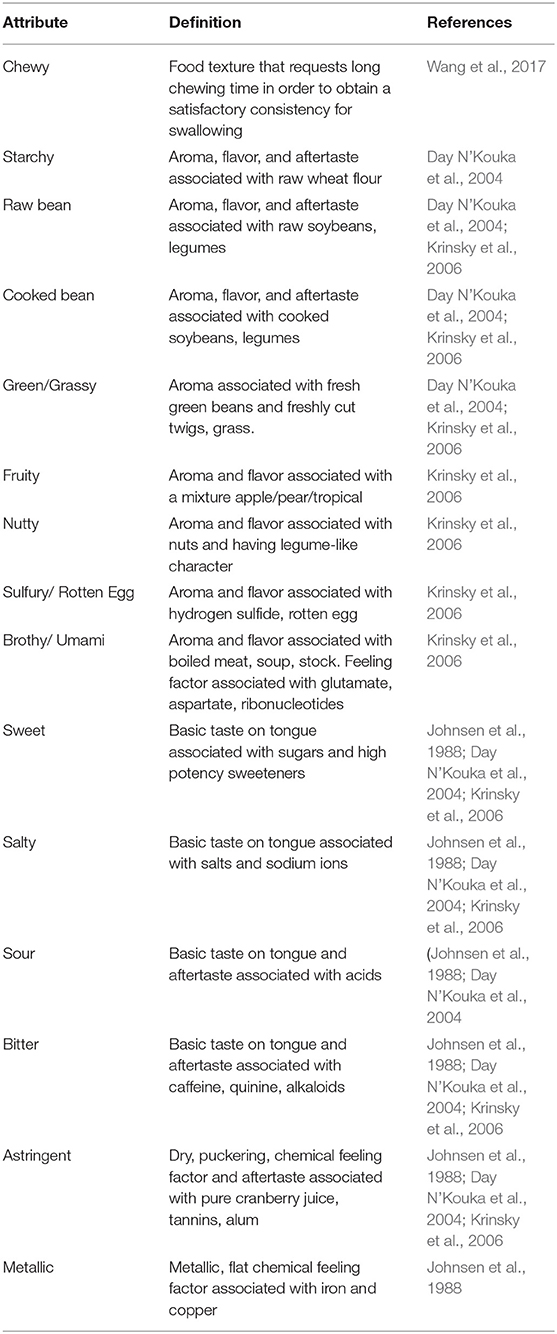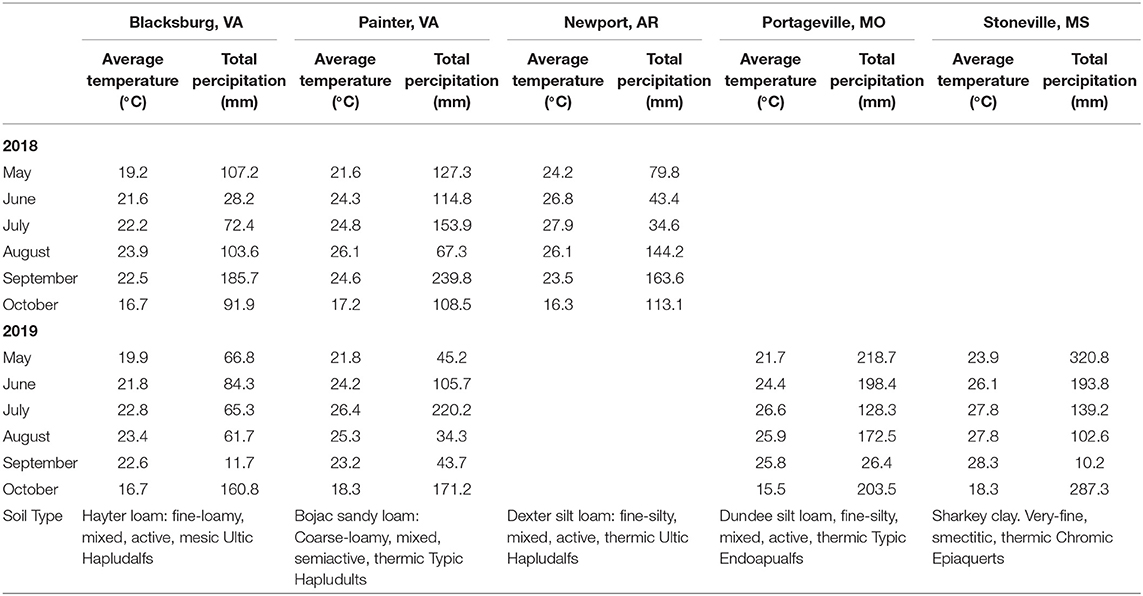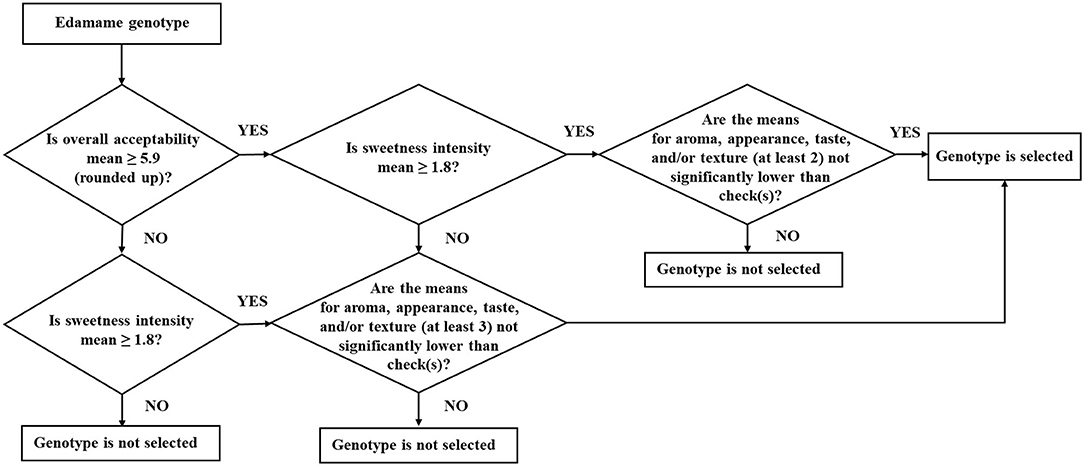Utilizing Consumer Perception of Edamame to Guide New Variety Development
- 1Department of Food Science and Technology, Virginia Tech, Blacksburg, VA, United States
- 2Department of Agricultural and Applied Economics, Virginia Tech, Blacksburg, VA, United States
- 3School of Plant and Environmental Sciences, Virginia Tech, Blacksburg, VA, United States
- 4Department of Entomology, Virginia Tech, Blacksburg, VA, United States
- 5Department of Plant Pathology, Physiology, and Weed Science, Virginia Tech, Painter, VA, United States
- 6Eastern Shore Agricultural Research and Extension Center, School of Plant and Environmental Sciences, Virginia Tech, Painter, VA, United States
- 7Cooperative Extension Service, Department of Crop, Soil, and Environmental Sciences, University of Arkansas, Little Rock, AR, United States
- 8Fisher Delta Research Center, University of Missouri, Portageville, MO, United States
- 9USDA, Agricultural Research Service, Crop Genetics Research Unit, Stoneville, MS, United States
Consumption of edamame (vegetable soybeans) has increased significantly in the U.S. over the last 20 years. Although market demand has been increasing, most edamame is still imported from Asian countries. A team of multistate plant-breeding programs in the mid-Atlantic and Southeast U.S. has focused on developing new breeding lines that grow well in the U.S. and deliver what domestic growers, processors and consumers need and expect from their edamame. In our study, sensory evaluation was used to identify edamame genotypes and sensory attributes preferred by consumers to support breeding selection criteria. In the first year (reported as our “screening study”), 20 edamame genotypes were grown in three locations: Newport, AR, and Blacksburg and Painter, VA. In the second year (reported as our “validation study”), 10 edamame genotypes selected after our screening study were grown in Blacksburg and Painter, VA, Portageville, MO, and Stoneville, MS. In both years of research, untrained participants (adults; vegetable consumers not allergic to soy; N ≥ 50) used a traditional 9-point acceptability (hedonic) scale (1 = “dislike extremely”; 9 = “like extremely”) to evaluate overall-liking, aroma, appearance, taste, and texture, and a 5-point scale (1 = “not sweet,” 5 = “extremely sweet”) to evaluate sweetness intensity. Next, participants used a check-all-that-apply (CATA) list of selected sensory terms to describe the sensory characteristics of each edamame sample. Overall acceptability of edamame genotypes was significantly different among all genotypes (p < 0.05). Samples described as “bitter,” “sour” (flavor) or “starchy” (texture) were associated with lower acceptability scores while “salty” and “sweet” (flavor) were correlated with higher acceptability. Sensory data from the screening study were used to select the best genotypes by use of a defined decision process based on the consumer data. The validation study tested the selection decisions and further supported the genotype choices. Sensory evaluation is a powerful tool to direct breeders to improve market acceptability and develop new edamame genotypes. Both screening and validation studies illustrate the significant role of consumer sensory data in support of genotypes targeted for domestic (U.S.) production.
Introduction
Edamame, vegetable soybean [Glycine max (L.) Merr.], is a nutritious and high-value specialty crop that has been consumed in Asian countries for centuries and its consumption has increased in the U.S. in the past 20 years (Johnson et al., 1999; Wolfe et al., 2018). Edamame is rich in vitamins, dietary fibers, isoflavones, proteins, and essential amino acids (Masuda, 1991; Mebrahtu et al., 2004; Song et al., 2013; Ntatsi et al., 2018). Generally, edamame beans are consumed as a snack or added in salads, stews, and soups (Masuda, 1991; Konovsky et al., 1994; Mebrahtu and Devine, 2008; Kumar et al., 2011). Edamame has also gained popularity among growers and processors in the mid-Atlantic and Southeast U.S as it has been promoted as a potential alternative crop to replace some traditional crops whose production and value have been decreasing, such as tobacco (Ernst and Woods, 2001; Carson et al., 2011; Xu et al., 2012; Ogles et al., 2016). In order to increase the domestic production of edamame, improved seeds that grow well in the U.S. and deliver what U.S. consumers expect from their edamame products are needed. Therefore, in addition to improving nutritional profile and agronomic characteristics of edamame, breeders working on the improvement of this specialty crop for domestic production should also consider the sensory attributes of edamame, such as appearance, flavor, and texture, and consumer preferences (Carneiro et al., 2020).
The current quality and grading standards of edamame are mostly defined by the Japanese, who are still the major consumers and importers of this vegetable in the world (Sirisomboon et al., 2007; Wang, 2018). Traditionally, Japanese consumers prefer sweeter edamame, crisper beans, and flowery flavor, while American consumers prefer more mature beans that have a buttery flavor (Johnson et al., 1999). In a recent review article, Carneiro et al. (2020) summarized the limited information on U.S. consumer preferences for edamame. Despite the increasing consumption of edamame in the U.S over the last decades, only a few studies have investigated consumers' acceptability and preferences for edamame with focus on the U.S. market (Johnson et al., 1999; Young et al., 2000; Kelley and Sánchez, 2005; Wszelaki et al., 2005; Krinsky et al., 2006; Williams, 2015; Wolfe et al., 2018; Flores et al., 2019). Pod appearance, bean taste, aroma, and texture were reported as sensory attributes that significantly affect edamame acceptability among U.S. consumers, who have also shown higher preference for a moderate chewy texture and balanced sweet and nutty flavor (Wszelaki et al., 2005; Flores et al., 2019). Nevertheless, a broader understanding of sensory attributes that can contribute to increase consumer acceptability or may lead to consumer rejection of new edamame genotypes in the U.S. market is still needed to guide breeding programs in the country. This knowledge is also of great value to guide growers and processors in their business decisions. Sensory evaluation can provide essential information for breeding selections and development of new food crops (Hampson et al., 2000). However, there is a lack of information regarding how sensory data could be used in such decision processes. The objectives of this study were to evaluate acceptability of new edamame breeding lines, identify genotypes preferred by consumers in the U.S., and develop a protocol for using consumer sensory data to support breeding selection for edamame genotypes with high market potential.
Materials and Methods
In order to support edamame breeders in the process of selecting edamame genotypes for U.S. production, consumer studies were conducted in two sequential years. The material included edamame breeding lines developed by the breeding programs of Virginia Tech (V lines) and University of Arkansas (R lines), and released edamame cultivars (“Asmara” and “UA-Kirksey”) as references, commonly called “checks” by plant breeders. Edamame genotypes evaluated in each year are further detailed in sections Edamame Samples and Edamame Samples.
In both years of research, affective evaluation (acceptability) of overall and targeted attributes was completed by untrained consumers of vegetables; participants were adults (18+ years old) and not allergic to soy (N ≥ 50). Traditional descriptive analyses such as QDA (quantitative descriptive analysis) were not chosen for this project as they do not reflect consumers' acceptability of the samples, and require longer time investment and commitment of trained panelists, which can also increase costs (Carneiro et al., 2020). The faster check-all-that-apply (CATA) descriptive method, which has already been used with affective tests to support breeding programs around the world (Lado et al., 2010; Vela-Hinojosa et al., 2018), was chosen to help explain our acceptability data. Sweetness has been reported as one of the most important sensory attributes to differentiate edamame genotypes (Wszelaki et al., 2005; Flores et al., 2019); in this study sweetness intensity also was included to estimate how consumers in the U.S. may perceive the sweetness of our edamame breeding lines. Consumers were instructed to rate the intensity of the sweet taste compared to other cooked vegetables they typically included in their diet. Although the lack of calibration among panelists is a limitation of our study, the use of untrained panelists to evaluate intensity of edamame flavor characteristics (sweetness, beaniness, nuttiness, and oiliness) and support the selection of genotypes for production was previously reported by Young et al. (2000).
The first year of our research (summer 2018 to spring 2019) is further presented and discussed as the “screening study” [section Screening Study (Year 1)]; it was an exploratory study and was the first year of edamame genotype screening supported by consumer sensory testing. Consumer data obtained in the first year helped us to determine criteria standards for genotype selection of edamame. It also guided the development of a decision tree, which contributed to reducing the total number of edamame genotypes to be analyzed in the sequential year of research.
The second year of our research (summer 2019 to spring 2020) is further presented and discussed as the “validation study” [section Validation Study (Year 2)]; it served as a validation for the selected genotypes and the screening criteria suggested in the first year (screening study). Therefore, year 2 was not a replication of year 1. As described throughout the next sections, the methodology was partially changed from the first year to the second in order to address study limitations, challenges, and points of improvement identified after concluding the first year (e.g., drying step of edamame processing, sample preparation for sensory evaluation, and statistical design of sensory tests).
Screening Study (Year 1)
Edamame Samples
A total of 24 edamame genotypes were planted in the summer 2018 from the following growing locations: Newport, AR, and Blacksburg and Painter, VA. Twenty edamame genotypes were tested in the sensory panels: 2 edamame cultivars (“Asmara” and “UA-Kirksey”), and 18 advanced breeding lines (R08-4004, R13-5029, R14-16195, R14-6238, R14-6450, V09-4192, V10-3653, V13-0329, V13-0339, V13-1644, V15-0344, V15-0396, V15-0398, V15-0411, V16-0523, V16-0524, V16-0528, and V16-0547). Four genotypes (edamame cultivar “LV75” and 3 advanced breeding lines, R07-589, R15-10280, and R16-5336) presented color variability and/or low amount of beans from one or more growing locations, so their incomplete datasets were not included in this report.
Edamame pods were harvested between September and October, 2018, and stored in cold before processed at the Virginia Tech Food Processing Pilot Plant (Blacksburg, VA, USA) within 48 h after harvesting. Samples from more distant growing locations (Newport and Painter) were placed in coolers or Styrofoam boxes containing ice bags and shipped overnight in order to minimize quality changes; samples were processed the next day, upon receipt, at Virginia Tech facility. Distilled water was used in all processing steps, except in the initial washing, when Blacksburg tap water (pH 7.5, 78 mg/L total dissolved solids, disinfected with chloramines Yao et al., 2019), was used to remove most soil and dirt. Fresh edamame pods were placed in metal baskets, blanched (boiling water, 98 ± 1°C) for 1 min in a steam kettle (Legion Utensils Co., Long Island City, NY, USA), and then immersed in a cooling bath (4 ± 1°C) for 2 min to avoid over blanching. Then, samples were manually dried with paper towels, packed in re-sealable plastic storage bags, labeled, and stored in a −20°C walk-in freezer. Blanching was performed following processing conditions suggested by Sheu and Chen (1991), which were determined based on remaining activity of the lipoxygenase and peroxidase enzymes. The same processing conditions were also tested for microbial quality and safety by Pao et al. (2008), who reported that blanching edamame in pod at 98°C for 1 min eliminated inoculated Escherichia coli and Listeria monocytogenes (≈ 6 log cfu/g), and naturally occurring coliform, yeast, or mold counts were below detection levels. In January and February 2019, samples were thawed for ~8 h at 4°C in a walk-in fridge and were manually shelled. During this step, yellow beans were separated and discarded, as well as unhealthy beans with visible signs of pest or plant diseases (e.g., brown spots on pods). Shelled beans were stored in re-sealable plastic bags at ~20°C until the day before sensory evaluation.
Sensory Sample Preparation
Edamame beans were thawed overnight in a refrigerator (4°C), then cooked in polyethylene plastic bags for 4 min in microwave on high power (SHARP household microwave oven, model n° R-2W38, serial n°34328, 120 VAC, 60 Hz, Thailand, 1996) the day before each sensory panel. After cooled to room temperature (≈ 21°C), cooked edamame beans were placed in 2-ounce black and clear plastic cups with clear lids. Each black cup contained one bean (evaluated for overall acceptability) and each clear cup contained two beans (evaluated for additional attribute acceptability and characterization). A random 3-digit code was assigned to each edamame sample for identification and to reduce risk of bias. All cups were labeled with the 3-digit code equivalent to the sample they contained and were kept refrigerated until served. Participants were not given any information about the samples that could influence their decisions.
Sensory Evaluation
The 20 edamame genotypes that had enough beans from all three growing locations (section Edamame Samples) were randomly analyzed within a total of 10 sensory panels, which took place at the Virginia Tech Sensory Evaluation Lab (Blacksburg, VA, USA) in February and March, 2019. The study was approved by the Virginia Tech Institutional Review Board (IRB) for Research Involving Human Subjects (IRB 18-310). Participants were untrained volunteers and consisted of students, faculty, staff, and the general public from Virginia Tech and its surrounding area. Study recruitment was accomplished through physical and online distribution of advertisement flyers, posts on social media and VT Daily News, emails to individuals and listservs, and word-of-mouth. Participants were 18 years or older and vegetable consumers not allergic to soy; they were asked to review and consent to the study parameters in the first session in which they participated. In each sensory panel, a set of 6 edamame samples (samples from all 3 growing locations of 2 edamame genotypes chosen at random) was served to each participant to limit sensory fatigue. Samples were served in a monadic random order and each sample was analyzed by a minimum of 50 people. As the edamame sample set was always different in each one of the 10 sensory panels, volunteers were allowed to participate in one or more panels (up to 10 times) in a period of 6 weeks, but no more than once on a single day. Participants did not receive financial compensation; they were compensated with a snack and/or non-alcoholic beverage (valued at $1 or less per unit) after completing a session of the study.
Participants were seated in individual sensory booths with white daylight lighting and equipped with touchscreen monitor. Data were collected using Compusense® Cloud version 20.0.7373.25578 (Compusense Inc., Guelph, Ontario, Canada) on the monitor. Participants were instructed to first ensure the code on the sample cup was the same code as listed on the monitor, then remove the lid from the sample cup, taste the edamame bean presented in the coded black cup, and evaluate overall-liking of the sample using a 9-point hedonic scale (1 = “dislike extremely,” 9 = “like extremely”). In sequence, they were asked to use the same 9-point scale to evaluate acceptability of sensory characteristics of two edamame beans from the same sample (coded clear cup). Participants were directed to smell the beans to evaluate aroma and then visually assess appearance. Next, they were instructed to chew one bean and assess taste and texture liking, evaluate intensity of sweet taste using a 5-point scale (1 = “not sweet,” 5 = “extremely sweet”), and answer a check-all-that-apply (CATA) question using a list of sensory attributes to describe the sensory profile of each sample. Panelists could consume the second bean if needed to complete the assessment. The 15 descriptive terms included in the CATA list were chosen from literature and are shown in Table 1 (Johnsen et al., 1988; Day N'Kouka et al., 2004; Krinsky et al., 2006; Wang et al., 2017). Terms and definitions were available to participants at the beginning of each CATA question and, at the end of the question, the single words that could be selected were presented in a fixed order. Subjects received unsalted saltine crackers and a glass of water for refreshing their palate and rinsing their mouth between samples. In addition to the sensory test, volunteers participating for the first time were asked to first answer a demographic and behavioral survey, then answer an economics survey after the sensory evaluation (data not presented).
Validation Study (Year 2)
Edamame Samples
Ten edamame genotypes (1 cultivar, UA-Kirksey, and 9 advanced breeding lines, R14-16195, R14-6238, R14-6450, R15-10280, R16-5336, V10-3653, V16-0524, V16-0528, and V16-0547) were grown during summer 2019 in Blacksburg and Painter, VA, Portageville, MO, and Stoneville, MS. Eleven edamame genotypes were originally selected by breeders after the first year of research, but genotype R07-589 was not included in the sensory evaluation panels due to notable differences in color (reddish beans) in comparison to the other genotypes (greenish beans). Only edamame cultivar UA-Kirksey was used as a reference in the validation study because there were not enough seeds of Asmara cultivar to be planted in the second year. Harvest and processing occurred between August and October 2019. In order to reduce the variability that may be associated with shipping, samples from all four growing locations were placed in coolers containing ice bags and delivered within 24 h after harvest to be processed at Virginia Tech Food Processing Pilot Plant. Processing flow was similar to the first year (section Edamame Samples), but salad spinners were used for the drying step instead of manual drying with paper towels. Additionally, samples were manually shelled right after blanching and edamame beans were stored at −20°C until use.
Sensory Sample Preparation
The day before each sensory test, bags containing frozen edamame beans were placed in a refrigerator (4°C) for 4–6 h before cooking. Edamame beans were placed in a glass microwave-safe container, covered with a paper towel sheet and cooked on high power for 1.5 min in a R-2W38 Sharp microwave oven. After cooking, edamame beans remained in the glass container covered with a paper towel for another 1 min. Similar to the previous year (section Sensory Sample Preparation), beans were placed in 2-ounce black and clear plastic cups with clear lids after cooled to room temperature (21°C). However, in this study, the number of beans was increased compared to the previous year: overall acceptability (black cup) contained two beans instead of only one, and characterization (clear cups) contained three beans instead of two. As in the first year of research, samples were anonymized and all cups were labeled with random 3-digit codes, then kept refrigerated until served.
Sensory Evaluation
The research protocol was updated by researchers and approved by the Virginia Tech Institutional Review Board for Research Involving Human Subjects (IRB 18-310). Consumers were recruited to participate in up to four sensory panels (one per growing location), which took place at the Virginia Tech Sensory Evaluation Lab (Blacksburg, VA, USA) in February 2020. Recruitment method and selection criteria were the same as the previous year (session Sensory Evaluation). Participants were adults (18 years or older) who were vegetable consumers and not allergic to soy, and were students, faculty, staff, or the general public from Virginia Tech and its surrounding area. As the edamame sample set was different in each sensory panel (same 10 genotypes, but a different growing location every week), subjects who agreed with study parameters and signed the consent forms were allowed to participate in one or multiple panels in the period of 4 weeks, but no more than once a week. After completing a session of this study, participants were compensated with a snack and/or non-alcoholic beverage (valued at $1 or less per unit) for their time and efforts. In the first panel, in which volunteers participated, they were instructed to answer a demographic and behavioral survey before the sensory test, then answer a new economics survey (different then first year's survey) after the sensory evaluation (data not presented). Sensory studies were performed as described in section Sensory Evaluation (Year 1), but the experimental design was changed to a balanced incomplete block design (BIBD) that required a total of 90 participants per sensory panel. The BIBD allowed each edamame breeding line to be analyzed by 50 people, and the control (cultivar UA-Kirksey) to be analyzed by all 90 participants of the panel. Therefore, the new experimental design and the smaller number of genotypes allowed a direct comparison between the control and all breeding lines, which was an improvement in comparison with our screening study. In each panel, 6 edamame samples (5 randomly selected breeding lines and the control) were served in a monadic random order to each one of the 90 participants along with a glass of water and unsalted saltine crackers. Participants were asked to evaluate overall-liking and characteristics (aroma, appearance, taste, and texture liking, sweetness intensity, and the CATA), as described in section Sensory Evaluation.
Statistical Analysis
Hedonic and intensity scores were analyzed using analysis of variance (ANOVA) and multiple comparison of means were conducted using Tukey's Honestly Significant Difference (HSD) tests. Unchecked and checked terms in the CATA were assigned codes 0 and 1, respectively. Correspondence analysis (CA) was performed to investigate relationships between sensory attributes, genotypes, and growing locations. Penalty analysis (PA) was conducted to identify which sensory terms contributed to higher or lower hedonic and intensity scores. Statistical analysis was performed in R, RStudio, and JMP Pro® and a 5% significance level was considered for all tests.
Results and Discussion
Screening Study (Year 1)
Participants
A total of 182 untrained volunteers participated in the screening study. About 58% of the participants were female, 63% were 20–29 years old, 60% were white, Caucasian, and 56% had at least a bachelor's degree. Participants reported they intentionally consume vegetables at least once a day (71%), soy-based products a few times per month (39%), and edamame a few times per year (48%). Additionally, “like the taste” (65%) and “for heath reason” (45%) were reported as their main motivators to consume soy products.
Edamame Selection for Breeding Programs
The quality of edamame can be affected by environmental factors like soil, weather and climate (e.g., temperature, light intensity, rainfall), and season (Masuda, 1991). The growing regions have different soil types and weather conditions (Table 2).
The decision tree shown in Figure 1 was developed and used to assist breeders of Virginia Tech (V lines) and University of Arkansas (R lines) breeding programs in their selection criteria. In the screening study, 10 experimental edamame genotypes with the best sensory attributes were identified and suggested to continue in the next steps of the breeding programs mentioned above: V16-0547, V13-0329, R14-16195, V16−0524, R13-5029, V15-0396, V13-0339, R14-6238, V13-1644, and R14-6450. Previous studies reported overall acceptability for edamame cultivars varied between 5.5 and 6.84 based on a 9-point hedonic scale (1 = “dislike extremely”; 5 = “neither like nor dislike” 7 = “like moderately”; 9 = “like extremely”) (Kelley and Sánchez, 2005; Wszelaki et al., 2005). Thus, an overall acceptability mean score of 6.0 (“like slightly”) or higher on a 9-point hedonic scale was considered a good target for this study. Due to the fact sweetness plays a relevant role to differentiate edamame genotypes (Wszelaki et al., 2005; Flores et al., 2019), sweetness intensity mean score was considered an important score to be considered in our decision tree. As a reference, Young et al. (2000) reported the sweetness intensity mean score for a group of 31 edamame genotypes evaluated by untrained panelists was 1.85 (5-point intensity scale, 1 = “not intense,” 5 = “extremely intense”). In our decision process, we also considered that the combination of sensory characteristics that were within the same range of our references (cultivars Asmara and UA-Kirksey) would suggest potential commercial value.
In summary, our selected genotypes had a mean of 5.9 (rounded up) or higher for overall acceptability (OA) and/or mean of 1.8 or higher (1 = “not sweet”; 2 = “slightly sweet”; 5 = “extremely sweet”) for sweetness intensity (SI). The criteria for selection included a combination of at least four attributes, which necessarily included overall acceptability and/or sweetness intensity as described above, plus mean scores that were not significantly lower than the references for aroma, appearance, taste, and/or texture means (Table 3). Mean scores for each edamame genotype represent the average of all three growing locations scores. A large number of samples with limited amount of beans was a limiting factor for this study and required several days of sensory panels and a large number of volunteers. Ideally, all samples should be evaluated by all the participants to increase the statistical power of the study, but this was not viable. Thus, a smaller number of genotypes with larger amount of beans and a new experimental design were chosen for the validation study (year 2).
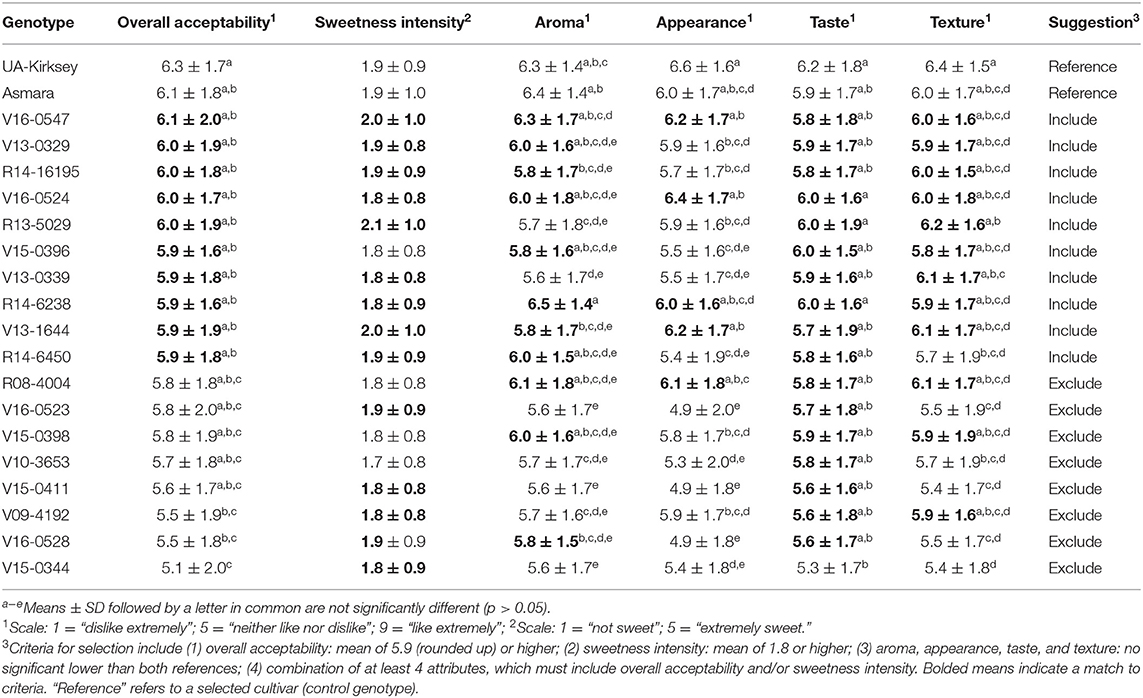
Table 3. Screening Study: Sensory scores (overall acceptability, sweetness intensity, aroma, appearance, taste, and texture) of edamame genotypes for breeding selection.
Edamame Acceptance
Panelists had very different opinions about edamame overall-liking. The average acceptance scores (mean value ± standard deviation; average of 3 growing locations) for edamame genotypes ranged from 5.1 ± 2.0 (V15-0344) to 6.3 ± 1.7 (UA-Kirksey, reference). Growing location did not have a significant effect in overall acceptability (p > 0.05). However, the interaction between genotypes and location was significant, as well as the genotype factor (p < 0.05), which means the changes in genotype scores were different depending on growing location. Wszelaki et al. (2005) investigated appearance of edamame pods and beans, aroma, taste, texture, and aftertaste of beans, and overall acceptability of six commercial edamame genotypes (Sapporo Midori, White Lion, Early Hakucho, Sayamusume, Misono Green, and Kenko), which were grown organically in Ohio. The hedonic scores reported in Table 3 were close to aroma, taste, and texture liking scores of edamame beans reported by Wszelaki et al. (2005). In their study, sweetness intensity was not investigated and panelists (N = 54, 46% females, ages between 20 and 60 years old) may have considered sensory attributes of edamame pods (not edible) to evaluate overall acceptability of their samples. In our study, both taste and texture mean scores ranged between 5 (“neither like nor dislike”) and 7 (“like moderately”), which was similar to the scores reported by Wszelaki et al. (2005). Appearance mean scores reported by Wszelaki et al. (2005) for edamame beans were between 6 (“like slightly”) and 7 (“like moderately”), which were higher than the mean scores obtained in this study (range: 4.9–6.6; 4 = “dislike slightly” and 7 = “like moderately”). However, aroma scores reported in their study were slightly lower (range: 5.3–5.7) than mean scores shown in Table 3.
The frequencies (percentages) at which sensory descriptors from the CATA question were used by our panelists to describe each edamame genotype are shown in Table 4. The most used descriptors were “cooked bean,” “green/grassy,” “chewy,” “nutty,” “raw bean,” “starchy,” and “sweet” (frequency >25% for most genotypes). Penalty analysis (PA) is a traditional tool used to analyze Just-About-Right (JAR) data; it has been used in the analysis of CATA data to understand how sensory attributes that are not in their optimal levels can cause drop in overall-liking scores (Qannari, 2017). Results of the PA performed using the overall acceptability scores showed the CATA attributes “salty,” “sweet,” “brothy/umami,” “nutty,” “cooked bean,” “fruity,” and “chewy” contributed positively to the acceptability of edamame genotypes when they were present, but liking scores dropped when the attributes “starchy,” “raw bean,” “metallic,” “green/grassy,” “astringent,” “sour,” “sulfury/rotten egg,” and “bitter” were used to describe the samples (Figure 2A). The CATA terms that were associated with higher acceptability of edamame samples were the same ones associated with higher taste scores. “Chewy” was the major sensory attribute associated with texture in our CATA list, followed by “starchy.” Blanching and cooking parameters (time and temperature) can affect edamame texture (Konovsky et al., 1994). However, as all samples were blanched and cooked following the same parameters, differences among hedonic scores were most likely associated with differences in genotypes and harvesting conditions. PA performed using the texture hedonic scores showed that lower texture scores were obtained when “chewy” was associated with the samples, but the opposite was observed for overall acceptability. “Starchy” had a negative impact on texture scores as well as observed for overall acceptability. Flores et al. (2019) reported increasing hardness was positively correlated to texture liking scores (based on an 11-point hedonic scale; 0 = “Do not like at all,” 10 = “Like extremely”). Hardness of edamame seeds was not measured in this study and is suggested for further research. Our results are in accordance with the study of Wszelaki et al. (2005) which suggested an equilibrium between sweet and nutty attributes, plus a moderate chewy texture would be preferred characteristics for edamame consumer in U.S.
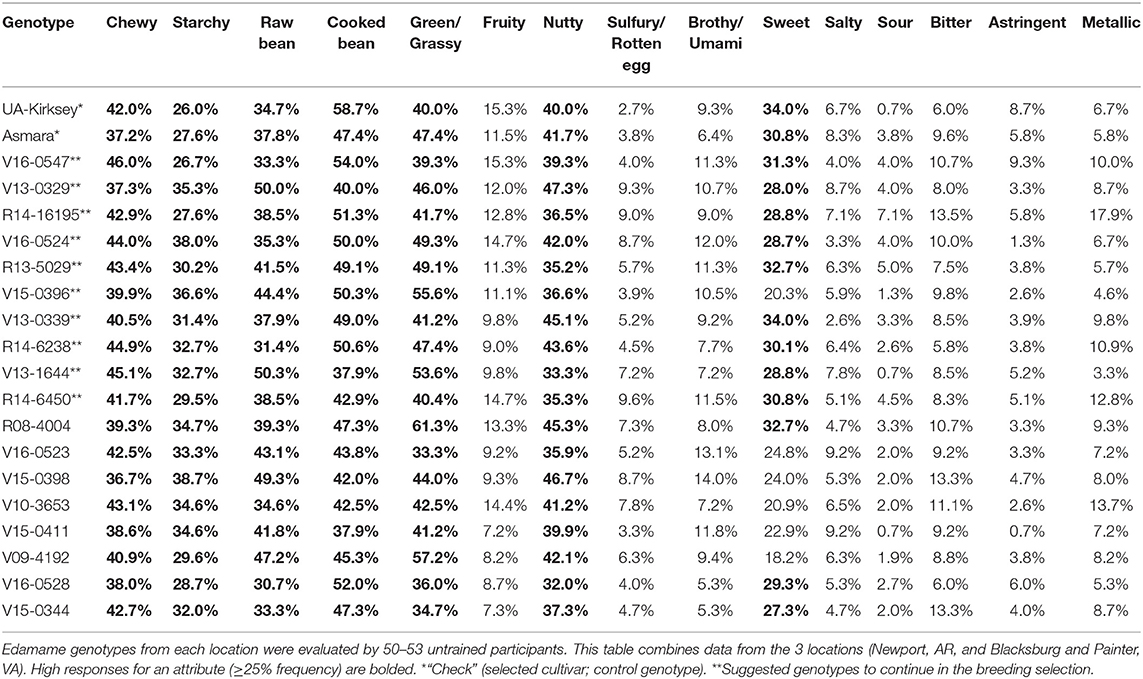
Table 4. Citation frequency (%) for sensory descriptors from Check-All-That-Apply (CATA) list used to describe edamame genotypes in the screening study.
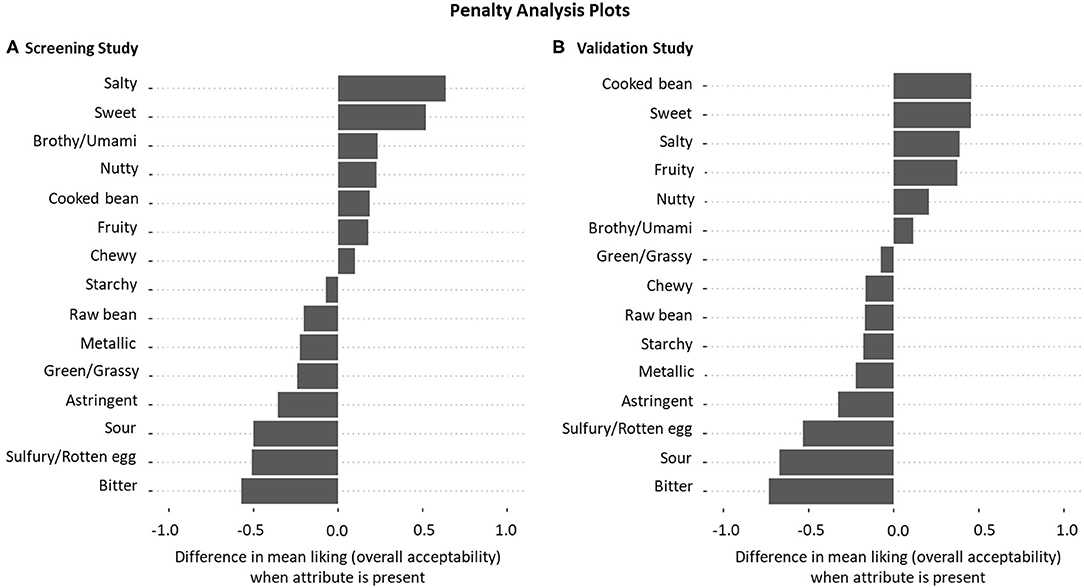
Figure 2. Penalty analysis plots representing the impact of sensory descriptors from the Check-All-That-Apply (CATA) list in the overall acceptability scores of edamame genotypes. (A) corresponds to the screening study and (B) corresponds to the validation study.
The relationship between genotypes and sensory attributes was verified through correspondence analysis (CA) (Figure 3A). The first two dimensions explained 51% of the variance of the data, which was a relatively small amount. Both references, Asmara and UA-Kirksey, and most genotypes that were suggested to continue in the breeding programs were associated with the desired attribute “sweet.” Savory flavor in edamame can be associated with amino acids content, and sucrose content is the major contributor to the sweet flavor (Konovsky et al., 1994). The suggested genotypes R14-16195 (OA = 6.0) and R14-6450 (OA = 5.9) were associated with the undesired attributes “bitter,” “sour,” and “metallic,” which can be an important aspect to be considered by the breeders. Bitter taste can be associated with the enzyme lipoxygenase, which concentration increases as beans mature, and/or the presence of saponins (Masuda, 1991; Konovsky et al., 1994; Young et al., 2000). Furthermore, the off-flavors “bitter,” “astringent,”, and “metallic” that contributed to lower taste scores are associated with undesired dry-mouth feeling (Masuda, 1991). In our study, lipoxygenase activity and saponin contents were not measured. It was assumed that processing conditions effectively inactivated oxidation enzymes present in the samples as the blanching method and time/temperature were suggested by others (Sheu and Chen, 1991). Thus, further investigation would be needed to understand whether bitterness of samples was associated with the genotypes, late harvest, or ineffective blanching. Our experimental blanching was the same for all genotypes we studied, so it is not likely that bitterness differences between genotypes were related to blanching effectiveness.
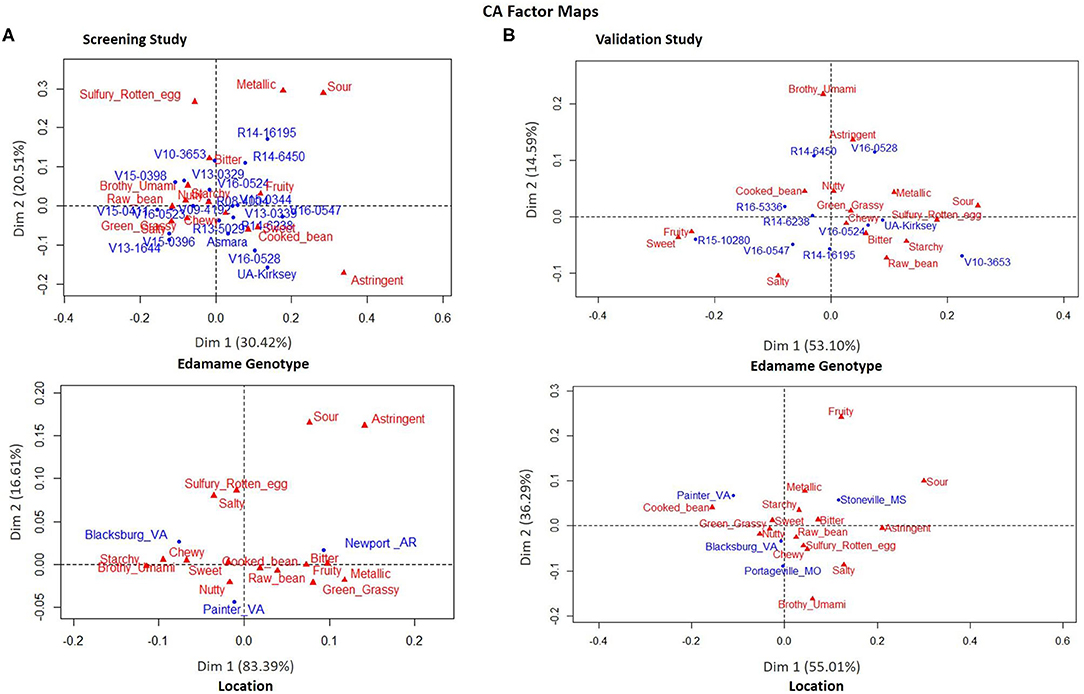
Figure 3. Correspondence analysis (CA) factor maps for edamame genotypes and growing locations. (A) correspond to the screening study and (B) correspond to the validation study.
Environmental factors can affect sensory traits and affect quality and value of vegetables (Ferreira et al., 2012). Thus, the relationship between growing location and sensory attributes was also verified and the first two dimensions of the CA explained 100% of the sensory space (Figure 2B). The CA factor map for location showed that samples from Newport, AR, were discriminated from samples from the other two growing locations in Virginia (Table 2). As explained by the first dimension of the CA map (83%), genotypes grown in Newport were more associated with the negative terms “sour,” “astringent,” “bitter,” “green/grassy,” and “raw beans,” while genotypes grown in Blacksburg and Painter, VA were more associated with the attributes “sweet,” “nutty,” and “chewy.” In addition, Blacksburg and Newport samples were also more associated to the terms “salty” (positive, as shown by PA plot) and “sulfury/rotten egg” (negative). This analysis may suggest Painter, VA, on the Eastern Shore and a region known for growing produce and vegetables, as the location with most potential to grow high-quality edamame; however, a deeper understanding of other factors like agronomic or climatic conditions, and harvest standards is needed to confirm this potential. Some genotypes may perform better (or lower) in one location than others, and in our study interactions between genotypes and locations were not controlled, which was a limitation of the study.
Validation Study (Year 2)
Participants
A total of 171 untrained volunteers participated in the validation study. Their demographic and behavior profiles were similar to the profiles reported in the screening study (section Participants). Participants were mostly female (51%), age between 20 and 29 years old (56%), white, Caucasian (46%), and had at least a bachelor's degree (68%). Most participants reported they intentionally consume vegetables one or more times per day (67%), soy-based products a few times per month (34%), and edamame a few times per year (50%). Lastly, their major motivations to consume soy products were also “like the taste” (48%) and “for health reason” (40%).
Edamame Selection for Breeding Programs
The decision tree developed in the screening study (Figure 1; explained in section Edamame Selection for Breeding Programs) was used again to suggest whether edamame genotypes should continue or not in the breeding programs after our validation study (Table 5). Regarding the edamame genotypes that were analyzed in the screening study, V10-3653 and V16-0528 were suggested to be excluded from the 2019 field trials, but they were selected by breeders to continue due to agronomic traits such as high fresh yield. As in the first year, V10-3653 (OA = 5.8) did not meet the selection criteria and was suggested to be excluded from the breeding programs, but V16-0528 (OA = 5.8) had a different performance and was suggested to continue in the program. Moreover, we observed that the overall acceptability of the reference UA-Kirksey in the validation study (OA = 5.9) was lower than previous year (OA = 6.3), but this variability could be due to the variable nature of consumer data. It was not possible to assure which factors mainly contributed to the reduced acceptability of this cultivar in the second year. However, the BIBD used to collect sensory data in our validation study allowed consumers to make better direct comparisons among multiple genotypes, which may have led to the changes observed in the mean scores. The breeding line R15-10280, which was not tested in the screening study due to low amount of beans from one growing location, had the highest overall acceptability (OA = 6.3) and sweetness intensity score (SI = 2.4) among all genotypes; it was also more preferred than UA-Kirksey in taste and texture. Therefore, R15-10280 was suggested as the genotype with the most preferred sensory profile and great market potential.
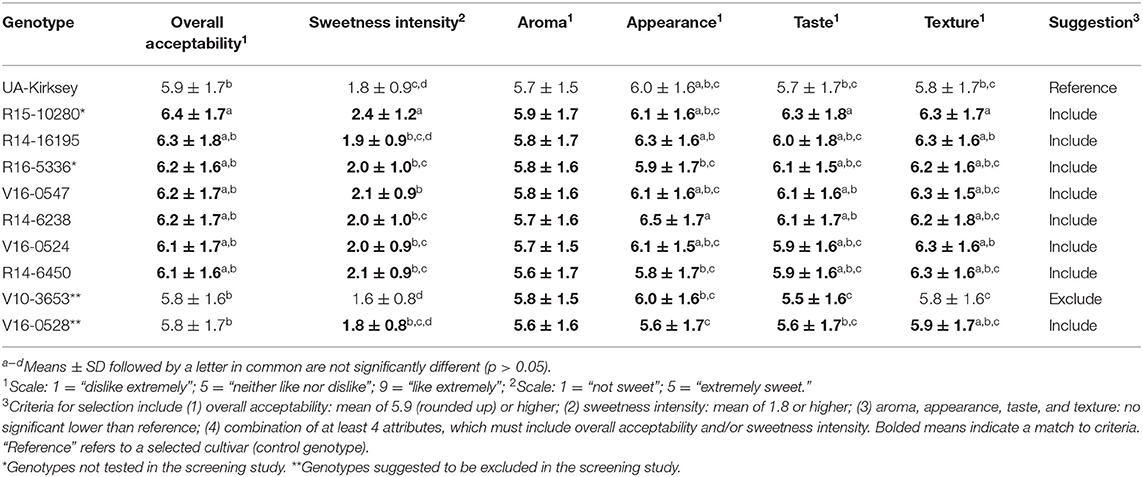
Table 5. Validation study: sensory scores (overall acceptability, sweetness intensity, aroma, appearance, taste, and texture) of edamame genotypes for breeding selection.
In both years, our decision tree (Figure 1) was used to suggest which edamame genotype should be included or excluded from the breeding programs based on our sensory data (Tables 2, 4). Overall, most suggestions (include or exclude) made after analyzing our validation study data confirmed the suggestions made in the first year, which suggests that our criteria were appropriate. Williams (2015) previously reported a set of criteria used to select edamame genotypes that included both agronomic and sensory characteristics of edamame, but almost no information was given about how sensory data was obtained or analyzed. The author only reported that sensory evaluation criteria was based on edamame (pods and seeds) being acceptable to a vegetable processor, which meant “two- to three-seed pods, green pods and seeds, seed free of blemishes, a smooth seed texture, and seed with a sweet and/or nutty flavor.” However, the references used to determine whether an edamame bean had a smooth texture, or a sweet and/or nutty flavor were not presented, which makes the criteria difficult to be replicated or adapted. On the other hand, the detailed sensory evaluation tests and decision process used in our study could be easily replicated in future edamame studies or adapted to guide other plant breeding programs in the development of improved vegetables, fruits and nuts.
Edamame Acceptance
Genotype, location and their interaction significantly affected overall acceptability scores (p < 0.05). As reported in Table 5, overall acceptability (mean value ± standard deviation; average of 4 growing locations) of edamame genotypes ranged from 5.8 ± 1.7 (V16-0528) to 6.4 ± 1.7 (R15-10280). The frequencies (percentage) of which sensory terms from the CATA list were used by our panelists to describe each edamame genotype are shown in Table 6. Similar to the screening study results, the terms “cooked bean,” “raw bean,” “green/grassy,” “chewy,” “starchy,” “nutty,” and “sweet” were the most used terms (frequency >25% for most genotypes). Penalty analysis (PA) confirmed the positive association between the sensory attributes “cooked bean,” “sweet,” “salty,” “fruity,” “nutty,” and “brothy/umami” and higher acceptability of edamame genotypes (Figure 2B). Therefore, these six flavor attributes were confirmed as desired sensory characteristics to be considered when breeding to develop edamame genotypes for the U.S. market. The descriptors “green/grassy,” “raw bean,” “starchy,” “metallic,” “astringent,” “sulfury/rotten egg,” “sour,” and “bitter,” once more, were associated with lower acceptability scores and were confirmed as undesired edamame sensory attributes for consumers in the U.S. According to Vara-Ubol et al. (2004), some sensory attributes like “brown” “green/pea pod,” “musty/dusty,” “musty/earthy,” “nutty,” and “starchy” flavors, sour aromatics, and a powdery feel (texture) can be associated with the undesired “beany” characteristic, frequently associated with soybean products. The PA of our validation study did not confirm the texture attribute “chewy” as a sensory characteristic associated with higher acceptability scores. Wszelaki et al. (2005) reported chewiness is an important sensory attribute to differentiate edamame genotypes and suggested it is a desired attribute that increases with maturity of pods and beans. Cooking can affect texture of edamame (Young et al., 2000); it is possible that our changes in microwave cooking conditions (sensory sample preparation) affected texture of the edamame beans. However, texture and appearance mean scores obtained in our validation study were, in general, higher than the mean scores obtained in our screening study, which suggests changes in microwave cooking were positive (edamame beans were placed in a glass microwave-safe container instead of being cooked in polyethylene plastic bags and microwave cooking time was reduced from 4 to 1.5 min). Although texture acceptability was evaluated in our study, further sensory and analytical studies are suggested to better understand which edamame texture characteristics are desired or preferred by consumers.
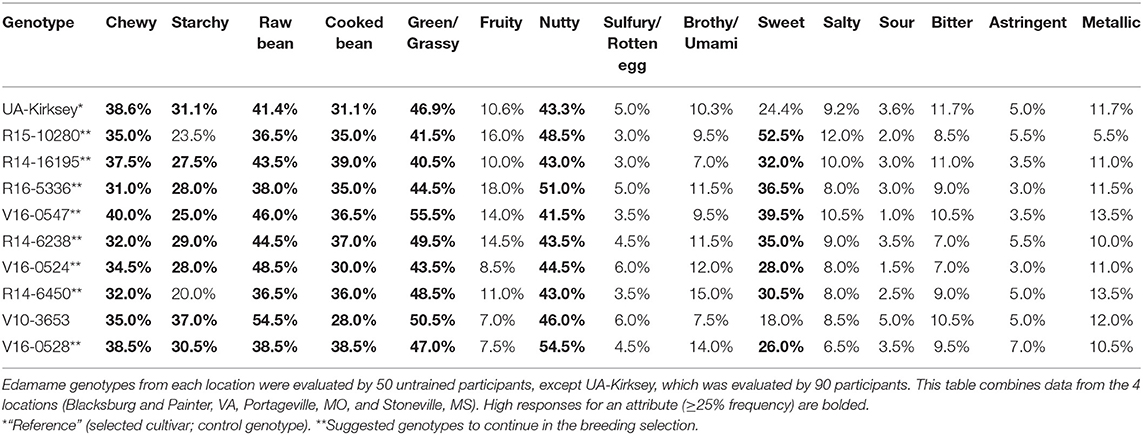
Table 6. Citation frequency (%) for sensory descriptors from Check-All-That-Apply (CATA) list used to describe edamame genotypes in the validation study.
Correspondence analyses (CA) were performed to verify relationships among sensory attributes and genotypes, and sensory attributes and growing locations (Figure 3B). The first two dimensions of the CA map for edamame genotype explained 68% of the sensory space. R15-10280 was the breeding line that obtained the highest scores for overall acceptability, sweetness intensity, aroma, taste and texture in our validation study. This genotype was highly associated with the sensory attributes “sweet,” “fruity,” and “salty” (third quadrant of the CA map). As opposed to that, V10-3653 was suggested both years to be excluded from the breeding programs and was mostly associated with the sensory descriptors “starchy,” “raw bean,” and “bitter” (fourth quadrant of the CA map). In our validation study, higher overall acceptability was observed for Painter, VA, but it was not significantly different from Portageville, MO, and Blacksburg, VA for the edamame grown in the 2019 season. Stoneville, MS, had the lowest overall acceptability, but it did not differ significantly from Blacksburg, VA. Environmental characteristics of all four locations are presented in Table 2. In the CA map for location (Figure 3B), Stoneville, MS was separated from the other three growing locations by the first dimension of the map. Samples from this location were more associated with the most rejected sensory attributes “bitter” and “sour.” The poor taste of the Stoneville samples may be partially explained by the historically high temperature and lack of rain immediately preceding harvest (Table 2). The two dimensions of the CA map for location explained 91% of the variance in the data. However, it was not possible to assure whether the differences shown by the sensory data were due to environment or harvest conditions. In fact, the 2019 season in Stoneville, MS was considered very hot, but irrigation was done only earlier in the season in this location, while in Painter, VA irrigation was done throughout the whole season. The different irrigation practices and climatic conditions (Table 2) may have contributed to the different edamame sensory profiles observed among growing locations, but might not be the only factors. Further investigation is suggested to identify the best practices to grow high-quality edamame in the U.S, and to better understand differences among growing locations, interactions between genotypes and locations, and identify best genotypes for the different growing locations (suitability).
Conclusion
Consumer studies performed in two sequential years successfully supported the selection of edamame genotypes and allowed the development of a decision tree that can be adapted to provide guidance to present and future plant breeding programs for incorporating consumer acceptability data to support breeding decisions. References and standards used for breeding selection criteria depend on the food crop (vegetable, fruit, nut) targeted for development or improvement. In our study, for example, it was chosen to exclude edamame genotypes with acceptability (hedonic) scores lower than 5.9, even when the scores were not significantly different than this standard. Additional criteria (sweetness; acceptability of additional attributes) were included to create a holistic evaluation. Thus, breeding selection results may differ among research groups that choose different references and standards for a same crop. Although in the first year of our research some statistical analyses were limited by the experimental design, the validation study (year 2) sustained the results of the previous screening study (year 1). A reduced number of samples (genotypes/growing locations) and larger availability of plant material for analysis (in this study, edamame beans) are recommended for future affective testing aiming to support breeding decisions because they allow the use of a more stringent experimental design, such as the BIBD used in the validation study. Overall, sensory data provided a better understanding of U.S. consumers' perception and acceptability of edamame; “salty” and “sweet” were confirmed as the major natural sensory attributes that drove higher acceptability scores, while “bitter” was highly associated with lower acceptability. Future work would benefit by the use of trained panels and descriptive sensory evaluation methods, such as QDA. Descriptive methods could be used to quantify valuable sensory attributes of selected breeding lines. As our edamame breeding programs continue, this valuable consumer information contributes to the improvement of edamame genotypes to be tested in the next years. It has also been contributing to the identification of advanced breeding lines with market potential in the U.S., such as R15-10280. This breeding line had consumer acceptability scores significantly higher than reference cultivar UA-Kirksey and was suggested as a strong candidate to be grown at the locations reported in this study and to be commercially released. However, different/new genotypes may have a better performance in different growing locations, which justifies breeding efforts to continue in order to find a genotype that best suits to those potential growing locations. Moreover, as edamame samples were discriminated by growing location, the fact that genotype interactions with environmental conditions (e.g., soil, weather) and agricultural practices (e.g., irrigation, pest, and weed control) were not controlled was identified as a limitation of our study. Further research is recommended to develop a better picture of each location potential to grow high-quality edamame and understand which best practices should be followed by growers. Our data for the edamame genotypes investigated in this study suggested Painter, VA as a good potential location to grow this specialty crop, but it was not possible to assure which main factor(s) contributed to the differences observed in acceptability (e.g., environmental and/or harvest conditions). In summary, consumer studies and sensory evaluation are valuable tools to guide breeders, growers, and processors in the development, selection, and production of high-quality edamame with sensory attributes desired by consumers in the U.S.
Data Availability Statement
The datasets presented in this article are not readily available because dataset is still needed to support further investigations and publications. Requests to access the datasets should be directed to Dr. Susan Duncan (duncans@vt.edu).
Ethics Statement
The studies involving human participants were reviewed and approved by Virginia Tech Institutional Review Board (IRB 18-310). The participants provided their written informed consent to participate in this study.
Author Contributions
RC, CN, and SD contributed to the conception and design of the sensory study. RC and DY worked on edamame processing. RC collected and analyzed sensory data, wrote first draft, and edited manuscript. BZ, JR, PC, and AG developed the breeding lines and managed the experimental plots that produced the edamame for this study. TK, SR, and MR provided agronomic support for the edamame throughout the growing seasons, identified harvest time, and harvested the edamame for this study. All authors reviewed, edited, and approved final version of the manuscript.
Funding
This work was funded by USDA-NIFA (Grant No. 2018-51181-28384; Accession No. 1016465), and, in part, by the Virginia Agricultural Experiment Station. This project was partially supported by the ARS Project Number 6066-21220-012-00D. Mention of trade names or commercial products in this publication is solely for the purpose of providing specific information and does not imply recommendation or endorsement by the U.S. Department of Agriculture. USDA is an equal opportunity provider and employer.
Conflict of Interest
The authors declare that the research was conducted in the absence of any commercial or financial relationships that could be construed as a potential conflict of interest.
Acknowledgments
The authors thank all members of our edamame team (faculty, staff, and students) for their dedication and hard work. The authors also thank all volunteers who took part in our consumer studies, Drs. Katherine Phetxumphou and Jacob Lahne for their assistance during the sensory tests and support with statistical analysis, and the Virginia Tech Statistical Applications & Innovations Group (SAIG) for their support with data analysis.
References
Carneiro, R. C. V., Duncan, S. E., O'Keefe, S. F., Yin, Y., Neill, C. L., and Zhang, B. (2020). Sensory and consumer studies in plant breeding: a guidance for edamame development in the U.S. Front. Sustain. Food Syst. 4:124. doi: 10.3389/fsufs.2020.00124
Carson, L., Freeman, J., Zhou, K., Welbaum, G., and Reiter, M. (2011). Cultivar evaluation and lipid and protein contents of Virginia-grown edamame. Horttechnology 1, 131–135. doi: 10.21273/HORTTECH.21.1.131
Day N'Kouka, K., Klein, B. P., and Lee, S. Y. (2004). Developing a lexicon for descriptive analysis of soymilks. J. Food Sci. 69, 259–263. doi: 10.1111/j.1365-2621.2004.tb13625.x
Ernst, M., and Woods, T. (2001). “Marketing challenges for emerging crops in Kentucky: vegetable soybeans,” in Second International Vegetable Soybean Conference (Tacoma, WA).
Ferreira, J. J., del Castillo, R. R., Perez-Vega, E., Plans, M., Simó, J., and Casañas, F. (2012). Sensory changes related to breeding for plant architecture and resistance to viruses and anthracnose in bean market class Fabada (Phaseolus vulgaris L.). Euphytica 186, 687–696. doi: 10.1007/s10681-011-0540-9
Flores, D., Giovanni, M., Kirk, L., and Liles, G. (2019). Capturing and explaining sensory differences among organically grown vegetable-soybean varieties grown in Northern California. J. Food Sci. 84, 613–622. doi: 10.1111/1750-3841.14443
Hampson, C. R., Quamme, H. A., Hall, J. W., Macdonald, R. A., King, M. C., and Cliff, M. A. (2000). Sensory evaluation as a selection tool in apple breeding. Euphytica 111, 79–90. doi: 10.1023/A:1003769304778
Johnsen, P. B., Civille, G. V., Vercellotti, J. R., Sanders, T. H., and Dus, C. A. (1988). Development of a lexicon for the description of peanut flavor. J. Sens. Stud. 3, 9–17. doi: 10.1111/j.1745-459X.1988.tb00426.x
Johnson, D., Wang, S., and Suzuki, A. (1999). “Edamame: a vegetable soybean for Colorado,” in Perspectives on New Crops and New Uses, ed. J. Janick (Alexandria, VA: ASHS Press), 385–387.
Kelley, K. M., and Sánchez, E. S. (2005). Accessing and understanding consumer awareness of and potential demand for edamame. HortScience 40, 1347–1353. doi: 10.21273/HORTSCI.40.5.1347
Konovsky, J., Lumpkin, T. A., and McClary, D. (1994). “Edamame: the vegetable soybean,” in Understanding the Japanese Food and Agrimarket: A Multifaceted Opportunity, ed A. D. O'Rourke (Binghamton, NY: Haworth Press), 173–181
Krinsky, B. F., Drake, M. A., Civille, G. V., Dean, L. L., Hendrix, K. W., and Sanders, T. H. (2006). The development of a lexicon for frozen vegetable soybeans (edamame). J. Sens. Stud. 21, 644–653. doi: 10.1111/j.1745-459X.2006.00088.x
Kumar, V., Rani, A., Goyal, L., Pratap, D., Billore, S. D., and Chauhan, G. S. (2011). Evaluation of vegetable-type soybean for sucrose, taste-related amino acids, and isoflavones contents. Int. J. Food Prop. 14, 1142–1151. doi: 10.1080/10942911003592761
Lado, J., Vicente, E., Manzzioni, A., and Ares, G. (2010). Application of a check-all-that-apply question for the evaluation of strawberry cultivars from a breeding program. J. Sci. Food Agric. 90, 2268–2275. doi: 10.1002/jsfa.4081
Masuda, R. (1991). “Quality requirement and improvement of vegetable soybean,” in Vegetable Soybean: Research Needs for Production and Quality Improvement, ed. S. Shanmugasundaram (Taiwan: Asian vegetable research and Development Center), 92−102.
Mebrahtu, T., and Devine, T. E. (2008). Combining ability analysis for selected green pod yield components of vegetable soybean genotypes (Glycine max). New Zeal. J. Crop Hortic. Sci. 36, 97–105. doi: 10.0014–0671/08/3602-0097
Mebrahtu, T., Mohamed, A., Wang, C. Y., and Andebrhan, T. (2004). Analysis of isoflavone contents in vegetable soybeans. Plant Foods Hum. Nutr. 59, 55–61. doi: 10.1007/s11130-004-0023-4
Ntatsi, G., Egea Gutiérrez-Cortines, M., Karapanos, I., Barros, A., Weiss, J., Balliu, A., et al. (2018). The quality of leguminous vegetables as influenced by preharvest factors. Sci. Hortic. 232, 191–205. doi: 10.1016/j.scienta.2017.12.058
Ogles, C. Z., Guertal, E. A., and Weaver, D. B. (2016). Edamame cultivar evaluation in Central Alabama. Agron. J. 108, 2371–2378. doi: 10.2134/agronj2016.04.0218
Pao, S., Ettinger, M. R., Khalid, M. F., Mebrahtu, T., and Mullins, C. (2008). Microbiological quality of frozen “edamame” (vegetable soybean). J. Food Saf. 28, 300–313. doi: 10.1111/j.1745-4565.2008.00121.x
Qannari, E. M. (2017). Sensometrics approaches in sensory and consumer research. Curr. Opin. Food Sci. 15, 8–13. doi: 10.1016/j.cofs.2017.04.001
Sheu, S. C., and Chen, A. O. (1991). Lipoxygenase as blanching index for frozen vegetable soybeans. J. Food Sci. 56, 448–451. doi: 10.1111/j.1365-2621.1991.tb05300.x
Sirisomboon, P., Pornchaloempong, P., and Romphophak, T. (2007). Physical properties of green soybean: criteria for sorting. J. Food Eng. 79, 18–22. doi: 10.1016/j.jfoodeng.2006.01.022
Song, J., Liu, C., Li, D., and Gu, Z. (2013). Evaluation of sugar, free amino acid, and organic acid compositions of different varieties of vegetable soybean (Glycine max [L.] Merr). Ind. Crops Prod. 50, 743–749. doi: 10.1016/J.INDCROP.2013.08.064
Vara-Ubol, S., Chambers Ivz, E., and Chambers, D. H. (2004). Sensory characteristics of chemical compounds potentially associated with beany aroma in foods. J. Sens. Stud. 19, 15–26. doi: 10.1111/j.1745-459X.2004.tb00133.x
Vela-Hinojosa, C., Escalona-Buendía, H. B., Mendoza-Espinoza, J. A., Díaz de León-Sánchez, F., Lobato-Ortíz, R., Rodríguez-Pérez, J. E., et al. (2018). Chemical and sensory analysis of native genotypes and experimental lines of tomato (Solanum lycopersicum L.). Fruits 73, 60–71. doi: 10.17660/th2018/73.1.7
Wang, K. (2018). East Asian food regimes: agrarian warriors, edamame beans and spatial topologies of food regimes in East Asia. J. Peasant Stud. 45, 739–756. doi: 10.1080/03066150.2017.1324427
Wang, S., Adhikari, K., and Hung, Y.-C. (2017). Acceptability and preference drivers of freshly roasted peanuts. J. Food Sci. 82, 174–184. doi: 10.1111/1750-3841.13561
Williams, M. M. (2015). Phenomorphological characterization of vegetable soybean germplasm lines for commercial production. Crop Sci. 55, 1274–1279. doi: 10.2135/cropsci2014.10.0690
Wolfe, E., Popp, M., Bazzani, C., Nayga, R. M., Danforth, D., Popp, J., et al. (2018). Consumers' willingness to pay for edamame with a genetically modified label. Agribusiness 34, 283–299. doi: 10.1002/agr.21505
Wszelaki, A. L., Delwiche, J. F., Walker, S. D., Liggett, R. E., Miller, S. A., and Kleinhenz, M. D. (2005). Consumer liking and descriptive analysis of six varieties of organically grown edamame-type soybean. Food Qual. Prefer. 16, 651–658. doi: 10.1016/J.FOODQUAL.2005.02.001
Xu, Y., Sismour, E., Pao, S., Rutto, L., Grizzard, C., and Ren, S. (2012). Textural and microbiological qualities of vegetable soybean (edamame) affected by blanching and storage conditions. J. Food Process. Technol. 3:165. doi: 10.4172/2157-7110.1000165
Yao, W., Gallagher, D. L., Marr, L. C., and Dietrich, A. M. (2019). Emission of iron and aluminum oxide particles from ultrasonic humidifiers and potential for inhalation. Water Res. 164:114899. doi: 10.1016/j.watres.2019.114899
Keywords: edamame, vegetable soybean, Glycine max (L.) Merr., sensory, consumer, plant breeding, food development
Citation: Carneiro R, Duncan S, O'Keefe S, Yu D, Huang H, Yin Y, Neill C, Zhang B, Kuhar T, Rideout S, Reiter M, Ross J, Chen P and Gillen A (2021) Utilizing Consumer Perception of Edamame to Guide New Variety Development. Front. Sustain. Food Syst. 4:556580. doi: 10.3389/fsufs.2020.556580
Received: 28 April 2020; Accepted: 15 December 2020;
Published: 18 January 2021.
Edited by:
Rakesh Bhardwaj, National Bureau of Plant Genetic Resources (ICAR), IndiaReviewed by:
Maria Ewa Rembialkowska, Warsaw University of Life Sciences, PolandMaria Giovanni, California State University, Chico, United States
Copyright © 2021 Carneiro, Duncan, O'Keefe, Yu, Huang, Yin, Neill, Zhang, Kuhar, Rideout, Reiter, Ross, Chen and Gillen. This is an open-access article distributed under the terms of the Creative Commons Attribution License (CC BY). The use, distribution or reproduction in other forums is permitted, provided the original author(s) and the copyright owner(s) are credited and that the original publication in this journal is cited, in accordance with accepted academic practice. No use, distribution or reproduction is permitted which does not comply with these terms.
*Correspondence: Susan Duncan, duncans@vt.edu
†Present address: Clinton Neill, Dyson School of Applied Economics and Management, Cornell University, Ithaca, NY, United States
 Renata Carneiro1
Renata Carneiro1  Bo Zhang
Bo Zhang